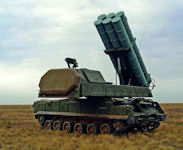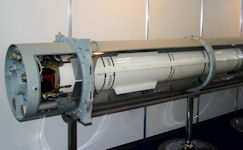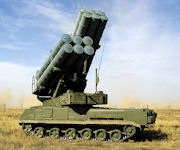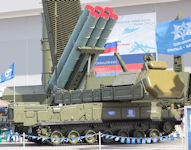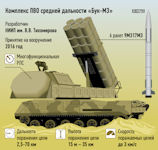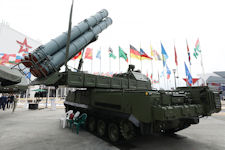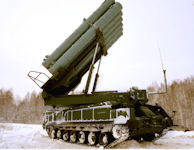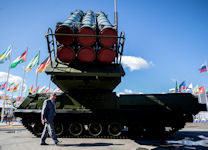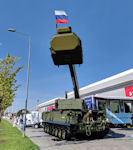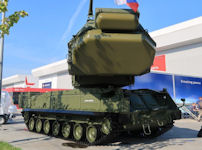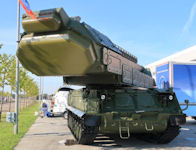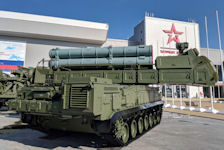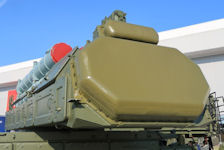SA-27 GOLLUM 9K317M Buk-M3 Viking anti-aircraft missile
The Buk-M3 also nicknamed Viking, medium-range surface-to-air missile system is a modernized version of the Buk-M2 system, features advanced electronic components and a deadly new missile, and is regarded as a completely new system. The data of the air defense missile system according to NATO classification are called SA-27 [GOLLUM].
Gollum is a fictional character in J. R. R. Tolkien's Middle-earth legendarium. He was introduced in the 1937 fantasy novel The Hobbit, and became important in its sequel, The Lord of the Rings. Gollum, originally named Sméagol (or Trahald), was at first a Stoor, one of the three early Hobbit-types. The name Gollum was derived from the sound of his gurgling, choking cough. His life extended far beyond his nature, by the effects of possessing the One Ring. Gollum was introduced in The Hobbit as "a small, slimy creature" who lived on a small island in an underground lake at the roots of the Misty Mountains.
"Buk-M3" is designed to combat maneuvering aerodynamic targets, shelling radio-contrast ground targets and destroy surface targets in conditions of intense fire and electronic countermeasures. It can simultaneously track 36 targets at altitudes from 5 m to 35 km and at a distance from 2.5 km to 70 km. Almost all Buk-M3 air defense systems are built on a new element base. For communication, the complex is equipped with modern digital communication facilities that ensure the uninterrupted exchange of both voice information and coded target distribution and target designation data. It is possible to use only missile guidance on the GOS, command, mixed.
The Buk M3 (Beech M3) is a brand-new Russian air defense system. It uses new missiles and has advanced electronic components. It has much-improved capabilities compared with the older Buk systems. It outperforms even the old S-300P long-range air defense system. A single Buk-M3 complex (including several launch vehicles) is capable of engaging up to 36 different targets simultaneously from any angle, while a single fire-control radar is capable of supporting the engagement of up to 6 different targets simultaneously within a sector 120° in azimuth and 85° in elevation.
In terms of organization, one Buk-M3 brigade would be expected to consist of four "divisions" (approximately a battalion set), with a single 9S52 Polyana-D4 Brigade C2 or similar vehicle in control of all four "divisions". One "division" is typically composed of three batteries, with one command vehicle and one search radar vehicle responsible for three batteries.
Each battery would be composed battery would consist of 2 launch vehicles. These launch vehicles can be either one 9A317M TELAR and a 9A316M TEL, or two 9A316M TELs and a single 9S36M illumination and guidance radar vehicle.
It should be noted that "division" means 'division', but this measurement takes on a different meaning when dealing with Russian anti-air unit sets as opposed to personnel or armor formations, and so the term has been transliterated rather than translated to reflect this difference of meaning and avoid confusion. It is perhaps most accurately translated into English as a battalion set.
Supplied to the troops as the "Buk-M3" and offered for export under its own designation "Viking", 9K317M represents the pinnacle of development of the family of medium-range anti-aircraft air defense missile systems of the ground forces under the general name "Buk". Over the almost half-century history of the continuous development of this line, the maximum target engagement range has tripled, reaching seventy kilometers, and the height has doubled, up to thirty-five thousand meters.
On 28 November 2016, the Almaz-Antey concern handed over the first brigade set of the Buk-M3 air defense system to the Russian Ministry of Defense. The Russian Armed forces will receive Buk-M3 air defense missile systems before the end of 2015, a source at Russia’s Defense Ministry told TASS on 08 March 2015. "Until the end of the year on weapons of air defense forces ground forces planned to take the newest anti-aircraft missile system" Buk- M3 "medium-range, in 2016 it will begin to enter the army," - said the source. It is assumed that the new complex will continue to range anti-aircraft missile systems "Buk". Modification "Buk-M2" is now considered one of the most efficient in its class. Its development was completed in 1988, but to deploy serial production was only 15 years later.
The development of the product line of the Buk family of air defense systems in the new, 21st century, was marked by the entry into service with the air defense of the Russian Ground Forces, first the Buk-M2 air defense system (2008), and then the Buk-M3 (2016). The main difference between them is the replacement of 3M317 missiles with 9M317M. Despite a slight difference in the designation (the suffix “M” is added), the latter represents a completely different product, with a reduction in weight by one and a half hundred kilograms, a total length of more than thirty centimeters, and a case diameter from 400 to 360 mm. Due to the lightness and compactness, the number of missiles placed on the SOU increased from four to six, on the ROM - from eight to twelve.
“Buk-M3” (factory index 9K317M) is a medium-range air defense system. The highly mobile multifunctional complex is designed to solve the following combat missions: the destruction of aircrafts of all types in all ranges of their practical use, the firing of radio-contrast ground targets and the destruction of surface targets under conditions of intense opposition, both fire and radio-electronic.
Military experts attribute the complex to the category of fixed assets of the military component of the OPS / Air Defense of the Russian Federation in the theater of operations and are considered as a backbone. On the tactical side, it is complemented by a short-range complex of the Tor-M2 type (at present) or Pantsir-C1 (in the near future). From the operational-tactical - long-range missiles of all classes in service. “Buk-M3” as the main means of counteracting the Kyrgyz Republic, flying at ultra-low altitude, demonstrates the best ratio of “cost-effectiveness” in comparison with all analogues of Russian and foreign production.
The key feature of the Buk-M3 complex is the new missiles, which, according to the description, “are almost twice as superior to previous developments and have no analogues in the world among anti-aircraft missile systems of their class . ” The description also states that the new type of ammunition is much lighter than the missiles that the Buk-M2 is armed with and is placed in a special container, which made it possible to increase the ammunition load from four to six missiles.
The air defense missile system is equipped with the latest CEC, which provides not only the solution of combat missions, but also the work in the training simulator mode for the education and training of crews. The tele-thermal system replaced the tele-optical sightings and is used to detect targets, their acquisition and passive tracking in automatic mode. The documentation system has been replaced by an integrated system of objective control, created on the basis of modern software using the latest CEC.
The development of the complex began in 1970, becoming a logical continuation of the 2K12 "Cube". Borrowing the key ideas of the "Cube" and a number of its elements, "Buk" was distinguished by more advanced means of radar through the use of "quasi-continuous signal" technologies. In the absence of artificial interference, the radars operated in pulsed radiation mode with range measurement, and when such were set by the enemy, they switched to a “quasi-continuous signal”, which made it possible to track detected air targets and direct missiles at them even in conditions of intense radio countermeasures.
The next difference was the equipping of launchers with their own illumination radar with the ability to view airspace in a narrow sector. While the Kuba battery was formed around the 1S91 self-propelled reconnaissance and guidance installation with two radars, in the case of the 3K37 Buk, it included a pair of firing installations with its own radars and one launcher without a radar. With the reduction in the number of vehicles from five to three, the battery could now simultaneously fire not one, but two targets, while maintaining the number of missiles ready for launch - twelve units.
the ROM transports 12 transport and launch containers with 9M317M missiles stored in them. If necessary, she is able to independently launch her entire arsenal. Since the 9A316M is not equipped with its own means of target illumination, missile guidance is carried out by means of the 9M317M combat vehicle accompanied by it. A pair of SOU + PZU located in position is capable of launching 18 missiles in a matter of seconds and simultaneously aiming them at targets due to the multi-channel equipment of the self-propelled firing system.
Signal processing and display equipment is also computerized and equipped with LCD monitors. For communication, modern digital communication facilities are installed on the complex, providing uninterrupted exchange of both voice information and coded data of target distribution and target designation.
Each division, armed with a Buk-M3 air defense missile system, has 36 target channels and is equipped with the latest models of rockets with active GOS. The complex has a wide range due to the fact that the new rocket has a vertical start. The 9R31M missile used to equip the complex is capable of destroying all currently existing aerodynamic targets, including highly manoeuvrable, under conditions of strong electronic countermeasures, also surface and ground. The onboard systems of the Buk-M3 complex are built on a fully updated element base. When supplying for the fleet of the Russian Federation, the complex is called "Hurricane". The export name of the sea version is “Calm”.
9K317M "Buk-M3" was developed by the Research Institute of Instrument named after VVTikhomirov. Chief designer of the air defense system EA Pigin. The development of the air defense system began in 1990. Tests of an air defense missile system with missile launches were conducted at the Kapustin Yar test site in 2005-2011. In 2011, state tests of the 9K317M air defense system with a 9M317M missile defense system were conducted. In particular, a successful launch of the "Flight" UAV target was held on December 14, 2011.
The rocket of the 9M317M complex was first shown at the international exhibition Defendory International - 2006 in Greece. At the end of 2013, the media stated that the entry of the Buk-M3 air defense system into the Russian Armed Forces is planned for 2016. In October 2016, the first division of the Buk-M3 air defense system was delivered to the Armed Forces of the country. The 9M317M missile has been produced by Dolgoprudny NPP since 2006.
The Buk-M3 is equipped with improved electronics and a new anti-aircraft missile. By the way, there are now six missiles on the self-propelled launcher - against four on the Buk-M2 and earlier. The probability of hitting the target reached 0.9999, and the firing range increased to 70 kilometers. The new "Buk" is capable of destroying any aircraft moving at speeds up to 3000 meters per second in the altitude range from 15 meters to 35 kilometers. Its missile is optimized to intercept low-flying cruise missiles, but can also be used against land and sea targets. The turret with anti-aircraft missiles and a guidance system is mounted on a GM-569A tracked chassis with a 710 hp multi-fuel engine. The maximum installation speed is 70 km / h, the cruising range is 500 km.
SOU 9A310 / 9A317- self-propelled firing system (SOU). A rotary launcher with four guides for missiles and a set of special electronic equipment was installed on a self-propelled tracked chassis. In front of the launcher there was a target tracking radar, also used to guide missiles. The main means of destruction was the self-propelled firing system 9A310. A rotary launcher with four guides for missiles and a set of special electronic equipment was installed on a self-propelled tracked chassis. In front of the launcher there was a target tracking radar, also used to guide missiles. The crew of 4 people. There were already 6 missiles in the TPK on the SOU 9A317 "Buk-M", it is also equipped with a tracking and illumination radar station with a phased antenna array.
SOTs 9S18 "Dome" This is a radar operating in the centimeter range, capable of detecting air targets at an altitude of up to 20 and a range of up to 120 kilometers. The station has a high level of noise immunity.
SPTSN 9S36/M is a caterpillar chassis or a towed semi-trailer with an antenna post on a retractable mast. Such equipment allows you to raise the phased array antenna to a height of up to 22 m and thereby improve the performance of the radar. Due to the relatively high altitude, targets are detected at ranges up to 120 km. According to the characteristics of tracking and guidance, the 9S36 station corresponds to the radar of self-propelled firing vehicles. It provides tracking of 10 targets and simultaneous firing of 4.
KP 9S470 /9S510M Designed to control the operation of the complex. It can work in conditions of active use of electronic interference by the enemy. The command post can process information about 46 air targets, it receives and processes data from six SOA and a target detection station, as well as from other air defense units. The command post identifies air targets, determines the most dangerous of them, and gives a task to each SOA.
ROM 9A39 / TPU 9A316M - designed for transportation and storage of missiles, while four missiles are on the guides of the launcher and are ready for launch, and four combat-ready missiles are on transport supports; loading of the SDA and self-loading with missiles located on the transport supports of the base, transport vehicle, ground lodgements or containers are intended; monitoring the health of the ROM and missiles, both on command from the SDA, and autonomously; pre-launch preparation and sequential launch of missiles. At the same time, however, due to the lack of its own tracking radar, external target designation was required according to the JMA data. A special crane was provided for reloading missiles. ( TPU 9A316M of the Buk-M3 complex accommodates -12 missiles)
The complex is equipped with 9R31M (9M317M) missiles with a high-explosive fragmentation warhead developed by the Almaz-Antey concern and manufactured by Dolgoprudnensky Research and Production Enterprise, which has a higher speed and can withstand large lateral overloads compared to the Buk-M2 missile. The missile is equipped with an inertial control system with an active radar seeker, which makes it possible to attack highly maneuverable targets in conditions of strong radio countermeasures, hit all existing aerodynamic targets, ground and surface targets, or operational-tactical missiles. The rocket engine starts on the main dual-mode (start - march) solid propellant rocket engine. An objective control system was installed, created on the basis of modern software using the latest CEC.
ZUR 9M38 / 9M317 is a solid-propellant single-stage rocket with a dual-mode engine. It has a semi-active radar guidance system and a high-explosive fragmentation warhead. At the initial stage of the flight, the correction is carried out by radio signals, and at the final stage - due to homing. To destroy air targets, a warhead weighing 70 kilograms is used, which is detonated using a proximity fuse 17 meters from the target. The striking elements of the rocket are the shock wave and fragments. The rocket is equipped with a solid-propellant engine operating in two modes, with a total operating time of 15 seconds. (9M317 with active RGSN).
The fourth-generation Viking mid-range air defense system (index 9K317M) is the next step in the development of the Buk family air defense system, the first models of which were put into service in 1980. Compared with the Buk-M2E air defense system, which is successfully exported to this day, the Viking air defense system has a number of key differences.
First of all, the complex received a new ZUR 9M317ME located in a transport and launch container that allows protecting the ZUR equipment from damage and adverse climatic conditions. Rocket propulsion system is a single-mode solid fuel engine. The mass of missiles at the Buk-M2E missile system was reduced from 710 to 600 kg, the maximum speed was increased from 1,200 to 1,520 m / s, respectively.
The complex is equipped with 9R31M (9M317M) missiles with a high-explosive fragmentation warhead developed by the Almaz-Antey concern produced by Dolgoprudnensky NPP, which has a higher speed and can withstand large lateral overloads compared to the Buk-M2 missile. The missile is equipped with an inertial control system with active radar homing, which allows you to attack highly maneuverable targets in conditions of strong radio resistance, hit all existing aerodynamic targets, ground and surface targets or operational-tactical missiles. The rocket engine starts on the main dual-mode (start-march) solid propellant rocket motor.
The use of a new missile defense system made it possible to increase the impact zone of aerodynamic targets with the Viking complex to 65 km. At the same time, the development of a new multi-function radar station, the introduction of new technical solutions in the radar information processing system allowed an increase in the number of target channels of the Viking air defense system to 36.
The simultaneous shelling of 36 targets flying from any direction inevitably requires an increase in the ammunition carrying capacity. Self-propelled fire installation (SOU) complex "Viking" has 6 missiles ready to launch. In addition, the possibility is still to give the SOU one launcher (PU), and to the radar illumination and guidance (RPN) - two PU.
It should be particularly noted that as part of the Buk-M2E air defense missile system, the launch-charging unit (ROM) had 8 missiles, 4 of them are ready for launch, and 4 are being charged instead of those put on the SDU or on the ROM itself. The newly developed PU Viking missile system has 12 missiles, ready for launch and placed on two swinging parts in packages from two TPKs with a fixed launch angle of 45 degrees. Introducing new technical solutions, the developers of the air defense system provided also wide possibilities for integrating the property already delivered to foreign customers into a single information exchange with the air defense system Viking, which will allow:
- to increase the maximum target range to 130 km and the height of the defeat to 30 km (using PU type 9A383ME from the Antey-2500 air defense missile system);
- Attach a SOW (RPN) from the Viking air defense system to a ROM from the Buk-M2E air defense system (using the 9M317 SAM missile). Thus, it is possible to use three types of missiles as part of one division (9M317ME, 9M317, 9M83ME);
- increase the target detection area to 360 km (when using the Sky-SVU meter 1L119 radar);
- to create a full-fledged echeloned air defense system (when working in conjunction with the Tor-M2E air defense system).
In addition, a “viewing station” mode has been added to the Viking air defense system, which allows the SOW (RPN) to conduct simultaneous tracking of up to 10 targets with the issuance of routes to the PBU (no targets are fired at this mode). Combat facilities of the complex, means of repair and maintenance at the request of a foreign customer can be installed on the tracked or wheeled chassis of high traffic or transport modules.
These characteristics and capabilities of the Viking air defense system allow us to confidently consider it one of the best means of protection against the enemy’s existing and prospective EIA today. In combination with the meter-delivered radar systems and launchers of long-range and short-range systems, the Viking air defense system is truly a universal anti-aircraft defense weapon for troops and the country's most important facilities.
On 24 February 2022, Russia launched a military operation in Ukraine . Vladimir Putin called its goal "the protection of people who have been subjected to bullying and genocide by the Kiev regime for eight years." For this, according to him, it is planned to carry out "demilitarization and denazification of Ukraine", to "bring to justice war criminals responsible for crimes against civilians" in Donbass .
The latest Buk-M3 anti-aircraft systems arrived in the Donetsk People's Republic in November 2022 to strengthen the air defense (air defense) of the region. The latest modification of the complex now protects the sky over the capital of the DNR. “The crews of anti-aircraft systems are combined into a single fire system and operate depending on the type and range of the enemy’s air object. The launchers of the Buk-M2 air defense system hit planes, helicopters and shells of HIMARS multiple launch rocket systems at a distance of about 40 kilometers. The Buk-M3 complexes ensure the detection and destruction of enemy air attack weapons at the distant approaches to protected objects," the report says.
The Russian Defense Ministry published footage of the operation of the Buk-M3 air defense system in the special operation zone, the crews of which provide reliable protection against air attacks by Ukrainian militants. The recording shows the movement of a self-propelled launcher with transport and launch containers in which anti-aircraft guided missiles are hidden.
| Range of action, km | 2.5–70 | |
| Target height, km | 0,015–35 | |
| Maximum target speed, m / s | 3000 | |
| missile guidance | inertial control system with a semi-active radar homing head (GOS) | |
| warhead | high-explosive fragmentation rod warhead with a remote radar fuse. | |
| number of target channels of the division | 36 | |
| Launcher | self-propelled fire installation (SOU) | |
| number of missiles on the SOU | 6 | |
| Type of vehicles | tracked, self-propelled | |
| DEVELOPER | NIIP named after Tikhomirov | |
| COUNTRY | Russia | |
| Alternative Designation | 9K317M Buk-M3 (SA-X-27); SA-17B | |
| Date of Introduction | 2016 | |
| Country Of Origin | Russia (RUS) | |
| Proliferation | Russian Federation | |
| Family | Buk | |
| Type | Medium-Range Air Defense Missile System | |
| Manufacturer | Almaz-Antey | |
| In Service | 2016-Present | |
| Crew | 4 ea | |
| Chassis | GM-5955 chassis | |
| Modifications |
| |
| composition of the complex |
| |
| TYPE | Fire Control Radar Vehicle | |
| Name | 9A36M | |
| Chassis | GM-5955 chassis | |
| Antenna | 21 m telescoping mast | |
| Radar Capability | detecting targets with an RCS of at least 2 meters squared out to a maximum range of 120 km | |
| Number of Targets | 10 simultaneous targets | |
| Steering | electronic beam steering | |
| Operating Mode | two: the first being a track while scan mode and the second being the pure target tracking mode | |
| TYPE | Self-propelled firing system | |
| CREW | 3, pers. | |
| POWER POINT Power, hp | 710 | |
| GEOMETRIC DATA | ||
| Length, m | 9.30 | |
| width, m | 3,250 | |
| Height, m | 3,800 | |
| WEIGHT DATA | ||
| Fighting mass , kg | 35.500 | |
| performance characteristics | ||
| Highway speed, km/h | 65 | |
| Range on the highway, km | 500 | |
| Crossable ditch, m | 1.5 | |
| Crossable ford, m | 1 | |
| WEAPONS | 6 x Rockets 9M38M 1 | |
Rockets 9M38M 1 | ||
| affected area in range | 2.5 - 70 km | |
| Height affected zone | 0.015 - 35 km | |
| number of simultaneously fired targets | 36 | |
| probability of hitting a target with one missile | 0.9999 !!!??? | |
| maximum speed of targets hit | 3000 m / s |
|
NEWSLETTER
|
| Join the GlobalSecurity.org mailing list |
|
|
|


